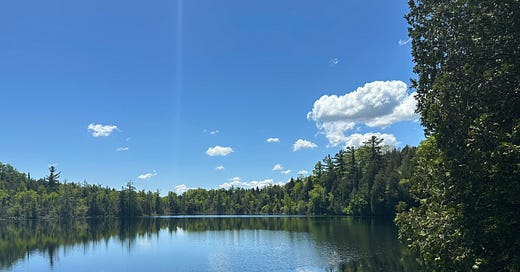A Lake that Tells Stories
Insufficient information vs my curiosity, and fun facts about a rare lake nobody asked for.
The teacher raised her voice to address the group, “This is a scientific lake, so don’t throw anything in the water”. The bunch of kids obeyed and continued their way to the visitor center.
The lake was small and, to be honest, not particularly striking at first glance. But what stood out to me wasn’t its appearance—it was the words used to describe it. “A scientific lake.” I don’t mean to criticize the teacher; I don’t know her or the purpose of the school trip. But I can’t shake the feeling that her words didn’t quite do the lake justice. They felt lacking—almost stingy, I’d say.
We were by the Crawford Lake in the Province of Ontario, Canada, about 47 miles from Toronto. It’s a meromictic lake, which means the layers of water do not intermix. Based on Wikipedia, the ratio between meromictic and holomictic (the normal ones) lakes worldwide is around 1:1000, so we were seeing a pretty rare and exceptional lake.
I get that we are all curious about different things. When Biko tries to explain some math to me, something he finds thrilling, I get bored and change the subject. But why not offer more information to those who are actually interested? Maybe one of those kids will become a scientist someday and make a ground-breaking discovery about meromictic lakes in a few years. Who knows?
I wouldn’t call myself a scientific thinker, but I am a curious person, and I’ve always loved learning about random new things. When I was a girl, my friends couldn’t understand why I would read books in summer. Weren’t we supposed to enjoy the summer holidays, doing nothing school-related? But to me, reading in summer was just as enjoyable as playing in the pool with friends or going for burgers at one of the two burger places in town.
If you have a curious mind like mine and want to know why Crawford Lake is “a scientific lake”, here are some fun facts I learnt during my visit last week.
If you find this boring as hell, please don’t feel obliged to keep reading. Go do your thing, just like I do when Biko tells me about something I find dull. He doesn’t take offence, neither do I. 😊
Crawford Lake is 74 feet deep, and due to its meromictic attributes, the lake’s water is separated into two layers.
Its upper layer is mixed with external factors, but doesn’t mix with its bottom layer.
Its undisturbed bottom layer allows sediment to accumulate at the lake’s bed.
Its storytelling power comes from its depths, because these layers can be read like tree rings, revealing a detailed environmental record for over a thousand years.
I’m not usually drawn to bodies of water where I can’t swim or do some kind of aquatic activity, but this natural lab fascinated me. Its significance in global scientific research is incredible—I got so caught up in it that I had to force myself to stop searching for more information. I can fall down internet rabbit holes pretty easily.
But if you do have the time to spare, here’s where you can read some more:
🔗 The official website of the Halton Conservation Area, in case you decide to visit. Conservation Halton, Crawford Lake
🎬 A cool video by a local realtor. I loved her style! Crawford Lake Conservation Area | Longhouses, Hiking & Golden Spike Meromictic Lake
🗞️ Two newspaper articles:
If you came across this newsletter by chance, subscribe to receive my upcoming emails.
If you like what I write and want to help this project grow, you can share A Platypus Life with others.
Until next time!
Maria Pia





